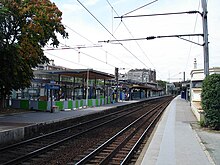The Train in the Snow
[1] Art historians typically emphasize the dividing lines of the piece created by the fence, trees, and tracks as well as the dark smoke produced by the locomotive.
[6] Furthermore, the effect of the train cars and station platform disappearing on the horizon are achieved through the "hazy outline" that blends the solid elements with the sky.
He attributes this optical illusion to Monet's use of converging lines created by the diagonals of the trees, fence, and train tracks, as well as the "sleek" nature of the engine itself.
[5] Marian Robinson further claims that the "suggestion of motion and power" in Monet's engines provides "an apocalyptic vision of potential destruction" brought on by the Industrial Revolution.
[6] James Rubin, on the other hand, believes that the lines of the fence and trees combined with the "softening effects of snow" sets the train in the "residential refuge" of suburban Argenteuil.
Additionally, Robinson claims that Monet's colors in The Train in the Snow "tint the dullness," matching "the ominous heaviness of Zola's brief scene."
Zola was familiar with Monet's train paintings, writing a positive review about them on display at the Third Impressionist Exhibition held in April 1877.
"[3] After his successful purchase, the doctor loaned The Train in the Snow to a Monet exhibition at the Galerie Durand-Ruel in 1883, where it attracted much positive attention from critics.
[3] In 1940, the painting was donated to the Musée Marmottan Monet in Paris by Bellio's daughter and son-in-law, Victorine and Don Eugene Donop de Monchy, where it remains today.

